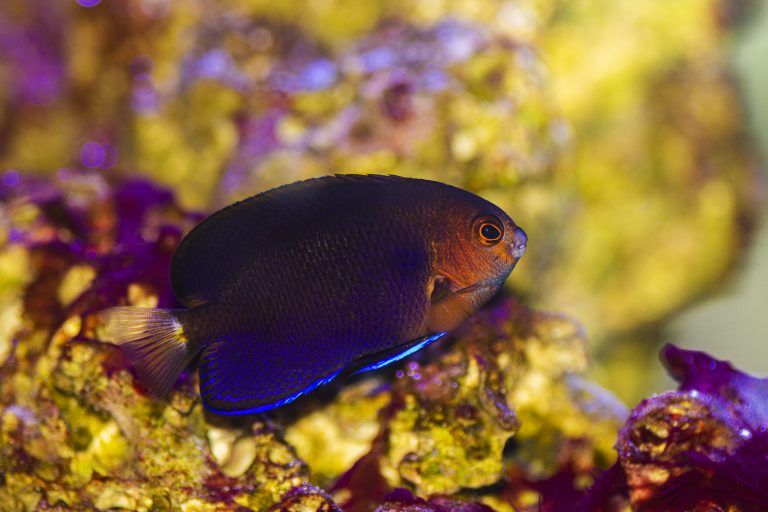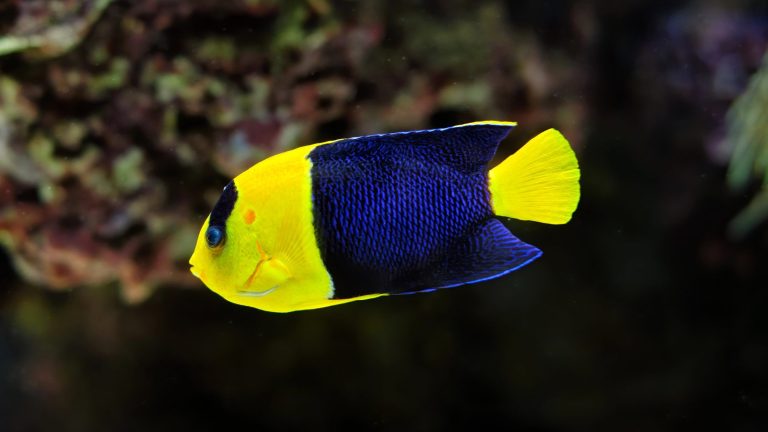Bicolor Blennies (Ecsenius bicolor) are small rock-dwelling saltwater fish that spend most of their day perching on rocks, grazing on algae, sitting in crevices, or hovering around their territory. These behaviors make them exciting fish to observe in an aquarium. The front half of the Bicolor Blenny’s body is a deep blue and the back half is a vibrant orange. The Bicolor Blenny is sometimes called the Flametail Blenny because of its striking orange coloration.
This fish species will grow to about 4 inches long and is generally peaceful. However, it will readily defend its territory and may pick on certain fish, which will be discussed later in this article. This article will also cover the Bicolor Blenny’s aquarium requirements, feeding habits, and more.
Aquarium Requirements
The Bicolor Blenny enjoys perching, grazing, and hiding in and around live rock. This species will set its territory around a patch of live rock and will do its best to defend it. It’s important to provide plenty of live rock of varying sizes and at least a 30-gallon aquarium so your Bicolor Blenny and other fish have plenty of room to set up territories and to find refuge from one another. More live rock also means more surface area that your blenny can use to graze on algae. It is useful if you have a stubborn fish that doesn’t consume processed food or are away from your aquarium and can’t feed your fish.
Blennies are notorious aquarium jumpers. They can find pretty small holes to escape out of. Placing a well-fitted lid over your aquarium is important and recommended to help lower the risk of your fish jumping out.
Are Bicolor Blennies Reef Safe?
Bicolor Blennies are generally considered reef-safe, but that’s not always true. I’ve owned Bicolor Blennies that have been model citizens and never bothered corals, but other marine fish keepers have had different experiences. It can be hit or miss with this species of Blenny. Sometimes fish go rogue, start out with not bothering coral, but suddenly get a taste for it. If you have high-end coral in your aquarium, it may not be worth risking getting this fish.
One suggestion I have been given is to place your Bicolor Blenny into a frag tank (if you have one) to see if it nips on frags. If it doesn’t there’s a likely chance it won’t bother the coral in your display tank. It’s not a foolproof system but it may give you an idea of what you’re working with. It’s also much easier to scoop a blenny out of a frag tank than to completely dismantle the reef tank to get it out.
Water Parameters
The water parameters the Bicolor Blenny needs are very similar to most other aquarium fish. They do best in temperatures between 72° and 78°F, but I usually keep them between 76° and 78°F. The dKH level in the aquarium should sit between 8 and 12. I recommend keeping the pH level of the aquarium between 8.1 and 8.4. The salinity level of the fish tank should be between 1.020 and 1.024 sg. Keeping water parameters within these ranges is important, but what I believe is very important is to keep your water parameters stable.
Food & Diet
It was mentioned earlier that Bicolor Blennies may be found grazing on algae. They do this because they have a predominantly herbivorous diet. Many blenny species are excellent algae eaters and are often added to aquariums to help keep hair algae at bay. The Lawnmower Blenny is one that received its name due to its habit of decimating algae in saltwater aquariums.
What happens if you run out of algae on your live rock? Luckily, this species isn’t picky with eating and should readily consume flake food, pellet food, algae sheets, and meaty foods such as Mysis Shrimp and Brine Shrimp. I recommend giving Bicolor Blennies a variety of foods with an emphasis on foods heavy on seaweed to help achieve a well-rounded diet.
Tank Mates
Bicolor Blennies are usually a pretty good option for a community-based saltwater aquarium. They should do fine with most peaceful saltwater fish. However, use caution when keeping them with similar-shaped fish, fish that use the same space in the aquarium, and predatory fish.
For example, I would not recommend keeping a Bicolor Blenny and a Lawnmower Blenny together because they utilize the same aquarium space and have a similar shape. However, a Midas Blenny and a Bicolor Blenny should not necessarily be an issue because both occupy different parts of the fish tank and have different appearances from one another. This is, of course, dependent on the size of the aquarium and the overall temperament of your specific fish. Otherwise, they should not have too many issues with other peaceful fish species.
Breeding
Finding a mated pair of Bicolor Blennies is quite hard because they are often territorial to others within their species. It is hard to nearly impossible to sex this fish species which adds to the challenge. Besides this, I have no other information on breeding Bicolor Blennies. There are instances where aquarists have had mated pairs in an aquarium, but I do not know and have not found any information on the successful breeding techniques of the Bicolor Blenny.
Final Notes
Bicolor Blennies are fantastic additions to an aquarium. I have kept many in reef tanks without issue and they rarely bother other fish in the aquarium. They’re great at picking on algae on live rock and have fantastic personalities when they explore their surroundings. I highly recommend checking out the Bicolor Blenny if your fish tank can fit one.
Thanks for clicking this tab, this is planned for a future feature of this website!




